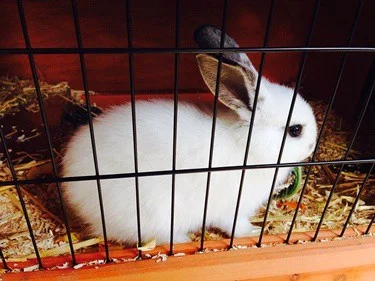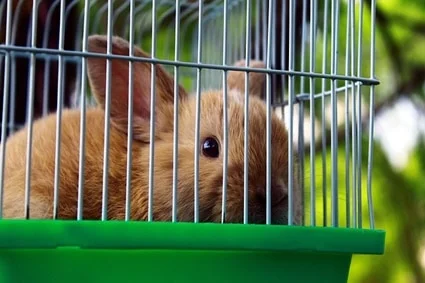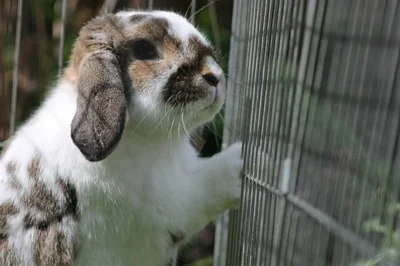Rabbits need water to remain healthy. So, they should be given constant access to a water bottle or other water source. However, the winter months can make this tricky. If your rabbit’s water bottle freezes, your pet can be left thirsty or even grow ill from dehydration.
There are methods you can use to keep your rabbit’s water bottle from freezing. The most fool-proof way is rotating out frozen bottles with thawed bottles that are kept indoors. Getting a sippy spout and insulating the outside of your rabbit’s bottle can also prevent freezing. Additives, like glycerin, can be added to water to slow its freezing time. Commercial heated water bottles also work well.
Aside from water bottles, you can also use water sources that are more resistant to freezing. These include crocks and automated water systems. While these methods can, in fact, still freeze, they’re far less likely to do so.
Freeze-Proof Rabbit’s Water System
Water is vital to a rabbit’s health. According to the Indian Journal of Animal Research, dehydration affects a rabbit’s heart rate, as well as weight loss. When left unattended, dehydration can lead to organ failure and even death.
Rabbits will need about 200 ml. of water per day, according to a study in the American Journal of Physiology. Ideally, rabbits should have unlimited access to clean water at all times. In colder temperatures, rabbits will also need more fuel – in the form of food and, of course, water – to keep themselves insulated.
But when it comes to sub-zero temperatures, how do you ensure your rabbit gets the hydration it needs? Here are some methods to keep your rabbit’s water bottle from freezing during the winter.
Rotate Bottles
The most straightforward method is keeping thawed water bottles on reserve. Do this by stashing a water bottle indoors at all times, so it remains unfrozen at room temperature.
When the temperature drops, just swap an outdoor, frozen bottle for an indoor, unfrozen one. Once that replacement freezes, swap it for another. You can easily bring the frozen bottle inside to thaw, but rabbits shouldn’t go longer than 8 hours without water.
When replacing the bottle, it’s ideal to warm up the new bottle slightly before placing it outside. This will keep it from immediately freezing. It may also help your rabbit feel cozier during wintertime.
Rotating bottles is one of the most effective methods. If you don’t own several rabbits or water bottles, it’s a straightforward process. However, if you have multiple outdoor pets to care for, this can become time-consuming.

Pick The Right Spout
Your rabbit’s water bottle spout can also play a role in keeping its water supply unfrozen. When picking water bottles, you can choose from two different spouts. One is a metal spout that contains a ball, which moves up and down to release water. The other spout is a sippy spout.
In colder months, the metal-ball design can freeze in place. As such, there may still be unfrozen water inside the bottle, but the rabbit cannot reach it. Compare this to the sippy spout design. Water will start to freeze in areas exposed to air. In a sippy cup, this means it will likely freeze from the top only – therefore, allowing the bottom to dispense water.
This won’t prevent the bottle from freezing completely over time, especially on cold nights. However, a sippy spout can slow the process, so you aren’t forced to replace the bottle often. It may even last through a cold spell with no input necessary from you.
Insulation
Insulation is a great way to keep your rabbit water bottle thawed. This shields the water from cold air, so it doesn’t freeze, much like your rabbit’s thick coat shields its body. You can easily make your own DIY insulator using items from around your home.
To make a bottle insulator, gather some bubble wrap and a thermal sock. A thick wool sock is great for this purpose. To create it, simply wrap the bubble wrap around the water bottle, and then wrap it again in a sock.
Glycerin
If you keep the water warm, this lengthens how much time the water bottle takes to freeze. However, if you find this timeline too short, you can turn to science. Add a few drops of glycerin to the water.
Glycerin, also known as glycerol, is a compound derived from vegetable oil or animal fat. When mixed in water, it can lengthen the time it takes for water to freeze.
Compared to other methods, this method may be less effective. Glycerol is clear and water-soluble, but it has a sweet taste. With a rabbit’s sensitive taste buds, it may not like the taste of glycerin.
Smaller Containers
To keep your rabbit’s water supply unfrozen, try using a smaller container, instead of a large bottle. With a small enough container, a rabbit may finish the water before it has the chance to freeze.
Of course, this requires more planning than the other methods. You will need more water bottles, all of which will demand constant filling. This is especially true if you own multiple rabbits. Finally, you will need to know how long it takes your rabbit to finish a bottle. Otherwise, you run the risk of leaving your rabbit without water.
However, with enough observation, and a lot of water bottles, this method can do the trick.
Heated Water Bottle
For those who don’t mind the cost, consider heated water bottles. These designs have a built-in heater, which can be plugged in to electricity. They also have a built-in thermostat, to keep water ice-free.
While this can be a good idea for some owners, this method may not be as reliable as other options. Mainly because there are very few heated water bottle products on the market. Water bottles with built-in features can be prone to breaking.
Additionally, any exposed wires may be chewed by your rabbits, regardless of anti-chew designs. These water bottles can be pricey. For those who own a lot of rabbits, this may not be the most financially sound.
On the other hand, heated water bottles can also serve as normal water bottles. You won’t be using this purchase only in the winter. It can pay off in the summer, too. All you need to do is unplug the device and use it like any other water bottle.
Warm Shelter
Keeping your rabbit’s shelter warm can help ensure your pet’s water source stays unfrozen. There are many ways to insulate your rabbit’s hutch.
You can place an insulator on top of the hutch. This can be of any insulating material you have lying around the house. For example, a tarpaulin or thick bedding can be a good choice. When placing your insulator, ensure that there is still a small gap for air to enter.
Aside from that, you can place a straw inside the hutch itself. Straw is ideal for trapping and holding heat, therefore warming the hutch. As a bonus, rabbits can burrow inside it to preserve their own body heat and grow more comfortable. Alternatively, you can also add a heating pad.
Heated Crocks Or Bowls
You can forgo a water bottle altogether by using crocks or bowls. In comparison to water bottles, they aren’t the best at keeping water clean. However, it’s easier to stop water from freezing in a bowl.
Likewise, there are a wide variety of heated crocks available on the market. Unlike heated water bottles, you won’t be limited in your options.
They are also more reliable than heated water bottles. This is because the heater and thermostat are located outside of the bowl. With heated water bottles, all the necessary technology needs to be inside the unit, making it more prone to damage.
If you don’t want to buy a heated crock, you can also create your own. All you need is to place a heat pad below a metal crock. Unfortunately, this won’t work with other materials, as metal is a heat conductor.
If you choose to simply rotate water sources, a crock may be easier to work with. Unlike water bottles, you can easily remove ice from inside a crock. This makes swapping out water sources easier, without waiting on thaw times.
How To Unfreeze a Rabbit’s Water Bottle
Unfreezing water can be more time and energy-consuming than preventing it from freezing in the first place. However, if you cannot avoid your rabbit’s water bottle freezing, you still have some options.
There are two main ways to unfreeze a rabbit’s water bottle. These are using warm water and clunking.

Warm Water
Submerging a frozen water bottle in warm water is the easiest way to unfreeze it. Alternatively, you can pour warm water over the bottle to help it thaw. However, both methods can be time-consuming.
When thawing water bottles, it’s best to stick to warm water, instead of hot water. The sudden change in temperature can break your bottle, no matter what material it’s made of. Additionally, anything involving hot water can be a safety hazard. However, this may lengthen the thaw time.
To help the water reach a good temperature, you can use a cooker, either with propane or wood. This can be an energy-efficient way to thaw water bottles, especially in remote areas.
When using hot water, be sure to avoid hot steam or touching the water with your bare hands. Also, make sure to keep your rabbit away from any hot water sources. The temperatures should cool down – from hot to warm – before your pet has access to drink it.
If you own many rabbits and need a steady supply of thawed water, try to establish a routine. Keep water bottles thawed by placing them in a tub of hot water. Replace frozen water bottles with these thawed bottles. Then, submerge these frozen bottles in the hot water, and repeat the process.
Clunking
Another method is called clunking. This involves taking a hammer and smashing the ice inside the bottle. That can be effective, but may damage the bottle itself. Water bottles made of plastic can make clunking easier.
Even with this strategy, you will need to thaw the ice inside the bottle. Smaller pieces will mean a quicker thawing time. However, leaving ice within the bottle limits how much water your rabbit can actually drink.
How To Prevent Freezing in Automatic Watering Systems
Aside from water bottles, sub-zero temperatures bring serious challenges to automated watering systems. In fact, these automated systems are the most prone to freezing. This is because the devices have two weak points.
Tubes
They work by feeding water through tubes or pipes. These tubes or pipes are then attached to drinking fountains inside a rabbit hutch. If one point freezes along the way, you’ll be hard-pressed to thaw it in a timely manner.
Drink Point
When a rabbit nibbles on the spout, an internal seal will open, delivering water into a rabbit’s mouth. When the rabbit leaves, the seal returns to its position. This leaves a wet point that’s exposed to air, causing it to freeze.
The best strategy is to prevent freezing, rather than try to thaw the damage. You can do this in two ways:
- Insulate the pipes that feed the water into your rabbit’s fountain. Insulated pipes and hoses vary in price, depending on the material used. These materials include polyethylene, elastomeric foams, and mineral wool.
- Use a thermostat, paired with a recirculation system. This type of system uses a thermostat to keep heated water in a reservoir. A pump then recirculates water to reduce the chance of freezing.
Water is essential for a rabbit’s health. It can be hard to ensure that your pet has a supply of water, even in the winter months. Hopefully, one of these methods will be helpful in keeping your rabbits safe and healthy.

